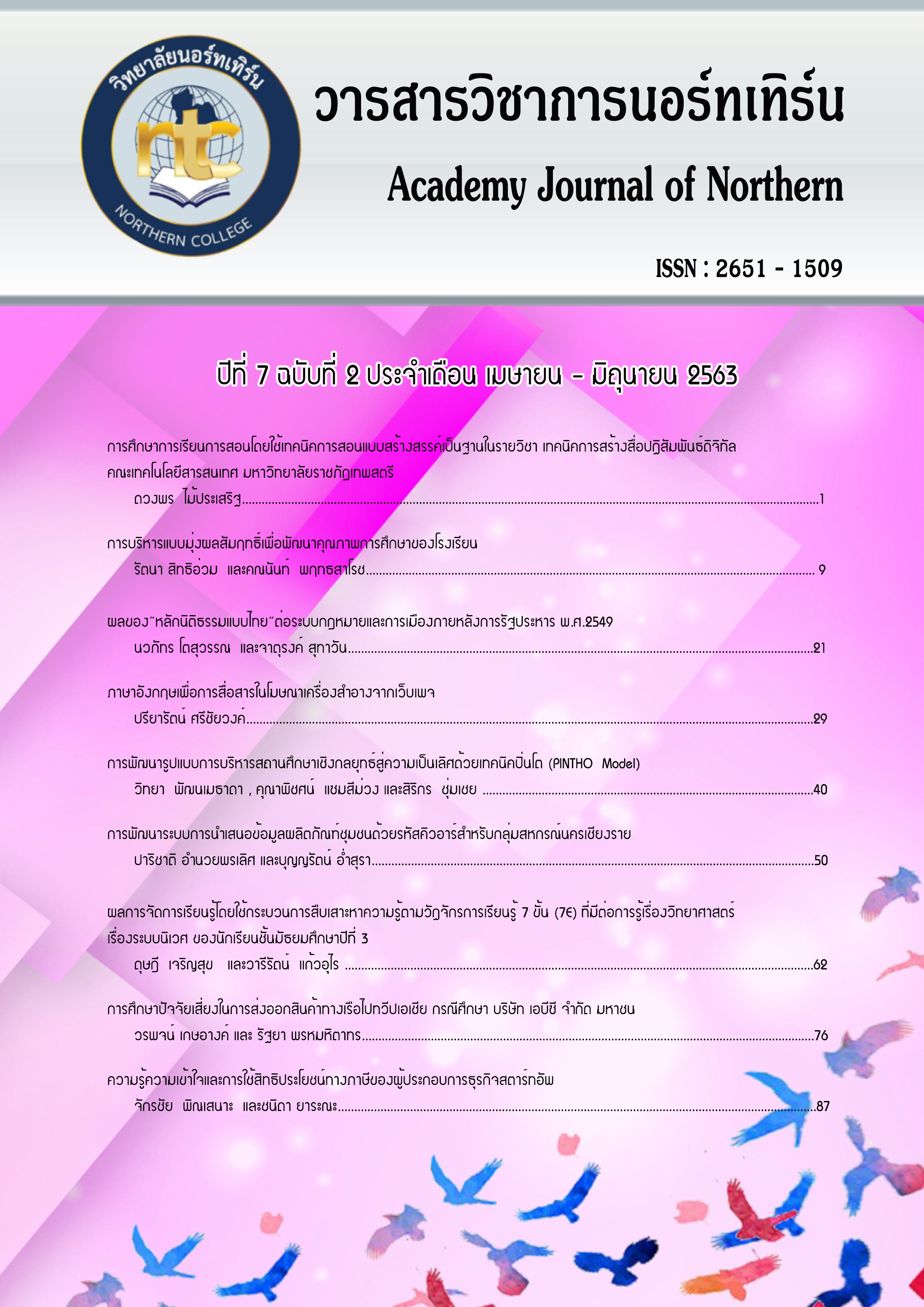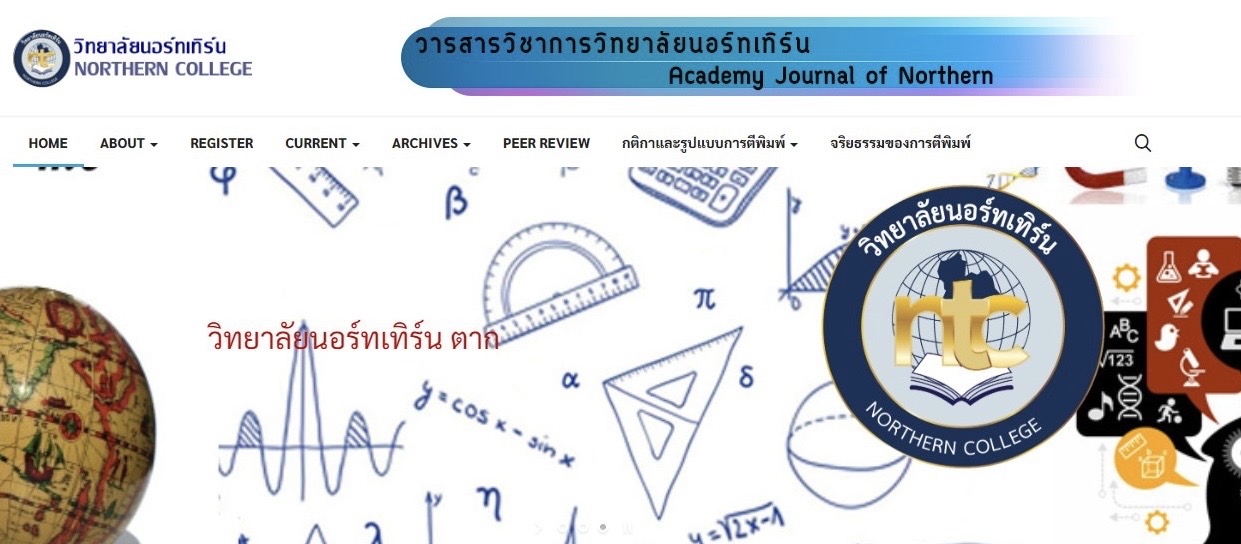ภาษาอังกฤษเพื่อการสื่อสารในโฆษณาเครื่องสำอางจากเว็บเพจ
คำสำคัญ:
ภาษาอังกฤษเพื่อการสื่อสาร, โฆษณาเครื่องสำอาง, เว็บเพจ, ภาษาเชิงเปรียบเทียบอุปมาอุปไมยบทคัดย่อ
การวิจัยครั้งนี้มีจุดประสงค์เพื่อศึกษาการใช้ภาษาเพื่อการสื่อสารที่ปรากฏในโฆษณาเครื่องสำอางด้านการเขียนภาษาอังกฤษเชิงโน้มน้าวใจและการเขียนภาษาอังกฤษเชิงเปรีย บเทียบ โดยศึกษาจากภาษาอังกฤษที่ใช้ในโฆษณาในเว็บเพจ วิเคราะห์ข้อมูลโดยการสุ่มตัวอย่างจากโฆษณาเครื่องสำอาง 10 ยี่ห้อ จำนวน 30 ผลิตภัณฑ์จากเว็บเพจ การศึกษาค รั้งนี้ได้รับการออกแบบเป็นงานวิจัยแบบผสม ทั้งเชิงคุณภาพและเชิงปริมาณ วิเคราะห์ข้อ มูลโดยการใช้กรอบข้อมูลของการสื่อสารภาษาอังกฤษด้วยการเขียนเชิงโน้มน้าว ภาษาเชิงเปรียบเทียบอุปมาอุปไมยและหาค่าความถี่ในรูปแบบร้อยละของคำที่ใช้ซ้ำกันในแต่ละโฆษ ณา
ผลการศึกษาพบว่าคุณสมบัติของภาษาอังกฤษเพื่อการสื่อสารที่ใช้ในการเก็บข้อมูลประกอบด้วย 2 รูปแบบ คือ โฆษณาเครื่องสำอาง ส่วนภาษาอังกฤษเพื่อการสื่อสารด้วยการเขียนเชิงโน้มน้าวมากกว่าครึ่งหนึ่งของการเขียนเชิงอุปมาอุปไมยและข้อมูลได้แสดงให้เห็นว่าข้อมูลที่นำมาวิเคราะห์ทั้งคู่โดยแบ่งเป็นร้อยละ ดังนี้ในโฆษณาเครื่องสำอางมีการใช้การเขียนเชิงโน้มน้าว ร้อยละ 83.33% และในโฆษณาเครื่องสำอางมีการใช้ภาษาเชิงอุปมา อุป ไมยเพียงแค่ร้อยละ 16.67%
เอกสารอ้างอิง
วิกีพีเดีย. (2020). การโฆษณา.[ออนไลน์].เข้าถึงได้จาก : https://th.wikipedia.org/wiki/%E0%B8%81%E0%B8%B2%E0%B8%A3%. (วันที่สืบค้นข้อมูล : 15 กุมภาพันธ์ 2563).
Chimombo, M.P.F. and Roseberry, R.K. (1998). The power of discourse : An Introduction to discourse analysis. New Jersey : Lawrence Elbaum.
Emilija A. Sakadolskis. (2003). The use of figurative language in the construction of musical meaning : a case study of three sixth grade general music classes. The Faculty of the Graduate School of the University of Maryland at College Park.
French, J.R.P. and Raven, B.H. (1959). The bases of social power. In : D. Cartwright Ed., Studies in social power. Ann Arbor: University of Michigan Press : 118-149.
Gibbs, R. W. and Jr. (1993) . Process and products in making sense of tropes. In A. Ortony (Ed.), Metaphor and thought (2nd ed.) .(pp. 252-276). Cambridge : Cambridge University Press.
Noam Chomsky. (1968). Language and Mind publ.Harcourt Brace Jovanovich, Inc., 1968. (3rd ed). Cambridge. Cambridge : Cambridge University Press.
Lasswell, H. D. (1948). The structure and function of communication in society. In: L. Bryson Ed., Communication of ideas. New York: Harper.
Littlewood. (1998). Communicative Language Teaching. (18th ed). Cambridge : Cambridge University Press.
Mac Cormac, E.R. (1985). A cognitive theory of metaphor. Cambridge, MA : The MIT Press.
M. J. Manfredo. (1992). Influencing Human Behavior : Theory and Applications in Recreation and Tourism (pp.1– 27). Champaign, IL: Sagamore Publishing.
Poompuang, Kanappati. (2005). English Usage in Perfume Advertising from the Web page. English for Business and Industry, King Mongkut’s Institute of Technology North Bangkok.
Surin, Benjamat. (2005). An Analysis of English Usage in Cosmetic Advertisement Headlines. English for Business and Industry. King Mongkut’s Institute of Technology North Bangkok.
Tangsriwong, Chathalai. (2003). An Analysis of English Sales Talk : A Case study of Communication strategies at Khao Sarn Road, English for Business and Industry. King Mongkut’s Institute of Technology North Bangkok.
Toris, C. C. M., White, P. and Hughes D. (1994) . Figurative language use in physician training groups. Poster presented at the Society of Southeastern Social Psychologists, Wake Forest University, Winston-Salem, NC.
Verbrugge, R. and McCarrel N. (1977). Metaphoric comprehension: Studies in reminding and resembling. Cognitive psychology, 9, 494-533.
ดาวน์โหลด
เผยแพร่แล้ว
รูปแบบการอ้างอิง
ฉบับ
ประเภทบทความ
สัญญาอนุญาต
ลิขสิทธิ์ (c) 2023 วารสารวิชาการนอร์ทเทิร์น

อนุญาตภายใต้เงื่อนไข Creative Commons Attribution-NonCommercial-NoDerivatives 4.0 International License.







